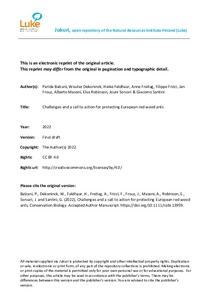Challenges and a call to action for protecting European red wood ants
Balzani, Paride; Dekoninck, Wouter; Feldhaar, Heike; Freitag, Anne; Frizzi, Filippo; Frouz, Jan; Masoni, Alberto; Robinson, Elva; Sorvari, Jouni; Santini, Giacomo (2022)
Balzani, Paride
Dekoninck, Wouter
Feldhaar, Heike
Freitag, Anne
Frizzi, Filippo
Frouz, Jan
Masoni, Alberto
Robinson, Elva
Sorvari, Jouni
Santini, Giacomo
Julkaisusarja
Conservation Biology
Wiley
2022
Julkaisun pysyvä osoite on
http://urn.fi/URN:NBN:fi-fe2022061747283
http://urn.fi/URN:NBN:fi-fe2022061747283
Tiivistelmä
Red wood ants (RWA) are a group of keystone species widespread in temperate and boreal forests of the Northern Hemisphere. Despite this, there is increasing evidence of local declines and extinctions. Here, we give an overview of the current protection status of RWA throughout Europe and review their IUCN threat classification. Only some RWA species have been assessed at a global scale, while not all national red lists of the countries where RWA are present include these species. In addition, different assessment criteria, inventory approaches, and risk categories are used in different countries, and data deficiency is frequent. The legislative protection is even more complex, with some countries protecting RWA implicitly together with the wildlife fauna, while others explicitly protect the whole group or particular species. This complexity often extends within countries, for example in Italy, where, outside of the Alps, only the introduced species are protected, while the native ones in decline are not. Therefore, an international, coordinated framework is needed for the protection of RWA. However, this first requires that the conservation target should be defined. Due to the similar morphology, complex taxonomy and frequent hybridization, protecting the whole RWA group seems a more efficient strategy than protecting single species, though with a distinction between autochthonous and introduced species. Second, an update of the current distribution of RWA species is needed throughout Europe. Third, a protecting law cannot be effective without the collaboration of forest managers, whose activity influences RWA habitat. Finally, RWA mounds offer a peculiar microhabitat, hosting a multitude of taxa, some of which are obligate myrmecophilous species listed in the IUCN Red List. Therefore, RWAs’ role as umbrella species could facilitate their protection if they are considered not only as target species but also as providers of species-rich microhabitats.
Collections
- Julkaisut [87088]
